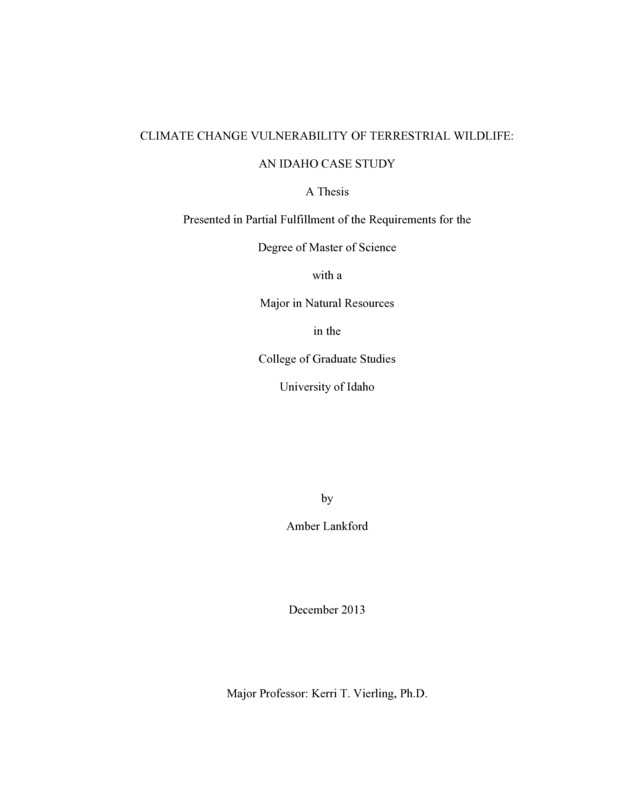Climate Change Vulnerability of Terrestrial Wildlife: An Idaho Case Study
Lankford, Amber. (2013). Climate Change Vulnerability of Terrestrial Wildlife: An Idaho Case Study. Theses and Dissertations Collection, University of Idaho Library Digital Collections. https://www.lib.uidaho.edu/digital/etd/items/lankford_idaho_0089m_10033.html
- Title:
- Climate Change Vulnerability of Terrestrial Wildlife: An Idaho Case Study
- Author:
- Lankford, Amber
- Date:
- 2013
- Keywords:
- Assessment Climate Change Idaho Vulnerability
- Program:
- Natural Resources
- Subject Category:
- Climate change; Wildlife management
- Abstract:
-
Climate change threatens the persistence and function of species, populations, communities, and ecosystems around the world. Projections for future climate indicate that increases in carbon dioxide and its associated effects to global climate will continue and even accelerate. The world has never faced such a rapid change in climatic conditions and has not experienced similar greenhouse gas concentrations for 3.6 million years. Understanding the potential affects that these changes have on natural systems and their components is vital in informing management focused on conserving and protecting biodiversity and natural ecosystem functions.
Increasing demand for tools for identifying species at-risk to climate change led to the development of a wide variety of climate change vulnerability assessments and tools. These tools, while based on the same general definition of vulnerability, represent a multitude of methods for evaluating the vulnerability of species to climate change. Although these assessments and tools are used to inform management actions, the similarity of their outputs has never been determined. Chapter 2 is dedicated to comparing the outputs of 3 widely available and commonly used tools. Results were poorly correlated between pairs of assessments. This indicates a lack of agreement in how vulnerability is ultimately calculated and a strong need for a more unifying and precise definition of vulnerability.
Chapter 3 addresses climate change vulnerability assessment shortcomings identified by Small-Lorenz and colleagues. The chapter outlines a format for incorporating spatial and seasonal variation of climate projections and species natural history. This model uses an ensemble mean of statistically downscaled region climate projections for the end of the century. The magnitude of change for 12 climate characteristics is weighted by 5 species sensitivity traits. A second model of species adaptive capacity assigns a permeability score to land cover vegetation macrogroups and is combined with trait-based adaptations. These models together constitute the vulnerability evaluation. An example using wolverine (Gulo gulo) provides the reader with context for how the framework can be applied. This framework is intended as a first-step towards the integration of more complicated characteristics of species and climate to produce more complete and accurate relative measures of vulnerability.
Vulnerability assessments, and development of tools and methodologies, are still novel when compared to understanding of other wildlife related threats. Future assessments need to focus on performing under a unified and more precise definition of vulnerability. Identification of reliable and critical data inputs will be vital to improving the predictive quality of future assessments. A cooperative effort towards evaluating relative vulnerability of wildlife and their habitats and ecological interactions, and integrating greater complexity through spatial and seasonal models is needed to bridge the gap between theoretical models and on-the-ground management actions.
- Description:
- masters, M.S., Natural Resources -- University of Idaho - College of Graduate Studies, 2013
- Major Professor:
- Vierling, Kerri
- Committee:
- Svancara, Leona; Lawler, Joshua
- Defense Date:
- 2013
- Identifier:
- Lankford_idaho_0089M_10033
- Type:
- Text
- Format Original:
- Format:
- application/pdf
- Rights:
- In Copyright - Educational Use Permitted. For more information, please contact University of Idaho Library Special Collections and Archives Department at libspec@uidaho.edu.
- Standardized Rights:
- http://rightsstatements.org/vocab/InC-EDU/1.0/

